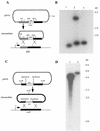The Salmonella typhimurium AhpC polypeptide is not essential for virulence in BALB/c mice but is recognized as an antigen during infection
- PMID: 9632587
- PMCID: PMC108334
- DOI: 10.1128/IAI.66.7.3208-3217.1998
The Salmonella typhimurium AhpC polypeptide is not essential for virulence in BALB/c mice but is recognized as an antigen during infection
Abstract
The OxyR regulon is known to mediate protection against oxidizing agents in Salmonella typhimurium. We reported previously that ahp, one of the OxyR-regulated loci, is induced during macrophage interaction (K. P. Francis, P. D. Taylor, C. J. Inchley, and M. P. Gallagher, J. Bacteriol. 179:4046-4048, 1997). We now report on the effects of disrupting ahp or oxyR on virulence in a BALB/c mouse model. Surprisingly, insertion of a Mudlux derivative within ahpC was found to result in attenuation, while irreversible inactivation of the locus through insertion of a cml cassette did not. An SL1344 derivative carrying an oxyR::kan disruption was also found to be as virulent as the parental strain. Moreover, both cell-mediated and humoral responses to AhpC were found to develop during the course of infection, probably through T-helper-cell (type I) activation. These results indicate that, although not essential for virulence, AhpC is expressed by S. typhimurium during infection of BALB/c mice and constitutes a target for the immune system.
Figures



Similar articles
-
Identification of the ahp operon of Salmonella typhimurium as a macrophage-induced locus.J Bacteriol. 1997 Jun;179(12):4046-8. doi: 10.1128/jb.179.12.4046-4048.1997. J Bacteriol. 1997. PMID: 9190824 Free PMC article.
-
Processing of viable Salmonella typhimurium for presentation of a CD4 T cell epitope from the Salmonella invasion protein C (SipC).Eur J Immunol. 2002 Sep;32(9):2664-71. doi: 10.1002/1521-4141(200209)32:9<2664::AID-IMMU2664>3.0.CO;2-N. Eur J Immunol. 2002. PMID: 12207351
-
Dual role for macrophages in vivo in pathogenesis and control of murine Salmonella enterica var. Typhimurium infections.Eur J Immunol. 2000 Mar;30(3):944-53. doi: 10.1002/1521-4141(200003)30:3<944::AID-IMMU944>3.0.CO;2-1. Eur J Immunol. 2000. PMID: 10741413
-
Oxidative stress response and characterization of the oxyR-ahpC and furA-katG loci in Mycobacterium marinum.J Bacteriol. 1998 Sep;180(18):4856-64. doi: 10.1128/JB.180.18.4856-4864.1998. J Bacteriol. 1998. PMID: 9733688 Free PMC article.
-
Tracking the dynamics of salmonella specific T cell responses.Curr Top Microbiol Immunol. 2009;334:179-98. doi: 10.1007/978-3-540-93864-4_8. Curr Top Microbiol Immunol. 2009. PMID: 19521686 Free PMC article. Review.
Cited by
-
Polyfunctional CD4+ T cell responses to immunodominant epitopes correlate with disease activity of virulent Salmonella.PLoS One. 2012;7(8):e43481. doi: 10.1371/journal.pone.0043481. Epub 2012 Aug 17. PLoS One. 2012. PMID: 22912884 Free PMC article.
-
Characterization of Escherichia coli DNA lesions generated within J774 macrophages.J Bacteriol. 2000 Sep;182(18):5225-30. doi: 10.1128/JB.182.18.5225-5230.2000. J Bacteriol. 2000. PMID: 10960109 Free PMC article.
-
Differential proteomic analysis of the Bacillus anthracis secretome: distinct plasmid and chromosome CO2-dependent cross talk mechanisms modulate extracellular proteolytic activities.J Bacteriol. 2006 May;188(10):3551-71. doi: 10.1128/JB.188.10.3551-3571.2006. J Bacteriol. 2006. PMID: 16672610 Free PMC article.
-
A Comprehensive Assessment of the Genetic Determinants in Salmonella Typhimurium for Resistance to Hydrogen Peroxide Using Proteogenomics.Sci Rep. 2017 Dec 6;7(1):17073. doi: 10.1038/s41598-017-17149-9. Sci Rep. 2017. PMID: 29213059 Free PMC article.
-
How does the oxidative burst of macrophages kill bacteria? Still an open question.Mol Microbiol. 2011 May;80(3):580-3. doi: 10.1111/j.1365-2958.2011.07612.x. Epub 2011 Mar 14. Mol Microbiol. 2011. PMID: 21375590 Free PMC article.
References
-
- Altuvia S, Almiron M, Huisman G, Kolter R, Storz G. The dps promoter is activated by OxyR during growth and by IHF and ςs in stationary phase. Mol Microbiol. 1994;13:265–272. - PubMed
-
- Becker-Hapak M, Eisenstark A. Role of RpoS in the regulation of glutathione reductase (Gor) in Escherichia coli. FEMS Microbiol Lett. 1995;134:39–44. - PubMed
-
- Bolivar F, Rodriguez R L, Betlach M C, Boyer H W. Construction and characterisation of new cloning vehicles. I. Ampicillin-resistant derivatives of the plasmid pMB9. Gene. 1977;2:75–81. - PubMed
-
- Bolivar F. Construction and characterisation of new cloning vehicles. III. Derivatives of plasmid pBR322 carrying unique EcoRI sites for selection of EcoRI generated recombinant DNA molecules. Gene. 1978;4:121–136. - PubMed
Publication types
MeSH terms
Substances
LinkOut - more resources
Full Text Sources
Molecular Biology Databases

